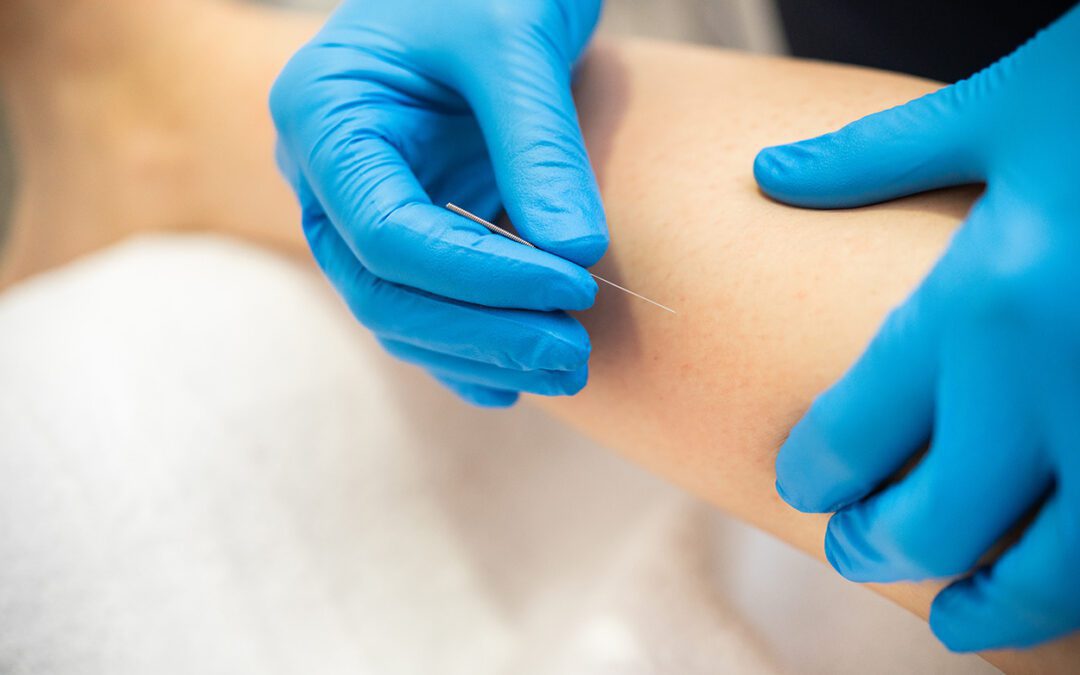Dry Needling, Functional Dry Needling, or Trigger Point Dry Needling, is a treatment that involves the insertion of small, thin, monofilament needles (those used in acupuncture) into tight, restricted muscles with the goals of decreasing muscle pain and dysfunction while increasing range of motion (ROM) and neuromuscular control.
One of the theories behind the cause of tight and restricted tissues is the increased amount of calcium and kinetic energy that are “stuck” within muscular tissue. When using dry needling techniques, the needle is used to promote a stimulus within the trigger point to assist with the release of the calcium and kinetic energy causing the biochemical change and overall releasing the tight, banded muscle.
Another use of this technique is to promote a neurophysiological change in the connection between the nervous system and muscular facilitation (NMES). In this technique, the use of dry needles in conjunction with neuromuscular electrical stimulation assists with the facilitation of the neuromuscular connections throughout the body. An example of this is when a patient has suffered from a stroke and now has difficulties with drop foot (or the inability to lift the foot during ambulation, stair navigation, etc.). The use of dry needling with NMES can help facilitate the muscles of the lower leg to contract in a regular rhythm to increase proprioception and coordination of the muscles involved.
Another use of dry needling is the direct “trauma” that is created throughout the muscle tissue. Depending on the specific technique: pistoning, periosteum pecking, redirections, etc can cause more or less trauma to the tissues. This “trauma” allows blood and healing properties to rush to the area to heal the dysfunctional tissues along with creating more biochemical changes with the release of energy “muscle twitches”.
Most people can benefit from dry needling in one way or another. However, there are some contraindications and precautions to follow.
Avoid these contraindications:
- Inadequate practical knowledge or comprised equipment
- 1st trimester of pregnancy
- Scalp area of infants
- Nipples, belly button (umbilicus), or external genitalia
- Uncontrolled anticoagulant (blood thinner) usage
- Compromised immune system
- Local infection of active tumor
- History of lymph node removal
- Back of the head region of patients with Arnold Chiari Malformation
- Area over a cardiac pacemaker (NO NMES)
- Areas over the ribcage or thoracic spine without advanced training
Relative Contraindications means that caution should be used in these situations:
- Controlled Anticoagulants
- Post Surgical (cleared by surgeon)
- Autoimmune Diseases
- History of Lymph Node Removal (depends on presence of lymphedema and clearance from oncologist)
- Respiratory Illness (acute, subacute, recovering, etc)
Some additional precautions to consider:
- Needle Aversion or phobia
- Significant cognitive impairment
- Communication barrier
- History of traumatic or spontaneous pneumothorax
- Severe hyperalgesia or allodynia
- Metal Allergy
- Abnormal bleeding tendency
- Vascular Disease
- Area of breast implant or spinal stimulator
- Area of laminectomy
- Scoliosis
- Severe Osteoporosis
- Post-Surgical (12 weeks in the area with vascular supply to surgical area, 6 weeks in an area without vascular supply to surgical area)
At Rejuv Medical, our physical therapist will work with you to determine if dry needling is right for you!

